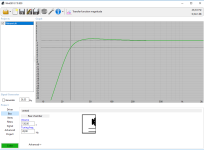Hi!In the screenshot that was provided, a slotted port was being used. Is the "0.732" end correction the appropriate one to be used for this condition?
Thank you @witwald for point out. I forgot to change the k factor.
I apologize @Onslo.
Since WinISD doesn't calculate it, I've applied the k=2.227 supposing the slot port would be like the one in the figure.
This way, the new tuning frequency would be 24,22 using the Lv formula.
With slot ports there might be other corrections such as the ratio of wide/height, right?
Maybe using a circular port is better, cause you can make adjusts by just changing the length of pipe.
Just plan the diameter correctly according to the length needed.
A 6" will require 47cm length for 28Hz tuning.
Maybe a 5" will get you more room to adjust since it requires only 30cm for tuning at 28Hz.
And if the enclosure is ready, with the slot port, you can first try to use 24Hz tuning - see below the simulation.
Still good FR
Do the calculations below make sense?
The 0.732 matches WinISD simulation - I supposed a circular port of 16cm to have the same area of 200cm2 in order to use the Lv formula.
If using 24Hz, you still have a good FR - 28Hz crossing at -3dB and a bit smooth roll off slope.
Attachments
For the following case modelled in WinISD,

VituixCAD produces a port length of Lv = 47.6cm for the tuning frequency of Fb = 28.54 Hz. For this calculation, I used a box Qa = 30, and in VituixCAD Lv changes when Qa is varied. Please note, port losses, as modelled by Qp, were kept constant, and a value of Qp = 20 was used.
I don't know why VituixCAD includes a coupling effect between Qa and Lv. Maybe a knowledgeable person can chime in?
VituixCAD produces a port length of Lv = 47.6cm for the tuning frequency of Fb = 28.54 Hz. For this calculation, I used a box Qa = 30, and in VituixCAD Lv changes when Qa is varied. Please note, port losses, as modelled by Qp, were kept constant, and a value of Qp = 20 was used.
I don't know why VituixCAD includes a coupling effect between Qa and Lv. Maybe a knowledgeable person can chime in?
That's a sealed enclosure then. Try for a Q of 0.5 plus plenty of EQ and a couple of kW of PA power amp - you don't want to be straining a puny hifi amp flat out!My priorities are
- clean tight bass rather than necessarily getting 20hz
- smallest reasonable foot print and high sensitivity as they will be pairing with high sensitivity mains.
Below is the VituixCAD simulation for the vented enclosure with Vb = 120 litres, tuned to Fb = 24 Hz, using a circular 5-inch (12.7-cm) diameter port, whose length is Lv = 43.4 cm. The simulation predicts a low-frequency cut-off with F3 = 31.3 Hz. The maximum passband SPL is about 111dB with 120W re 4 ohms of power input. Cone displacement seems moderate, and peak air velocity in the vent is just hitting the turbulence warning. As mentioned by @ron68 in an earlier post, this vented box alignment is interesting as it has an 8dB/octave roll-off rate at around 30Hz, and it should therefore be able to take advantage of room gain down to about 25 Hz or so.

Noting that the driver in question has a Qts = 0.49, a Qtc = 0.50 will require a largish enclosure, approximating an infinite baffle. A 120-litre sealed enclosure produces a Qtc = 0.66.That's a sealed enclosure then. Try for a Q of 0.5 plus plenty of EQ and a couple of kW of PA power amp - you don't want to be straining a puny hifi amp flat out!
Witwald can you explain or point me to a good link or article how the Qtc effects bass performance characteristics and how the calcs derive the number? I Know its gone off topic a bit but useful for newbs learning how to select drivers or to know where to use certain drivers.
